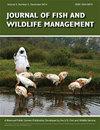夏威夷大岛国家野生动物保护区的森林鸟类种群
IF 0.9
4区 环境科学与生态学
Q4 BIODIVERSITY CONSERVATION
引用次数: 0
摘要
夏威夷特有的森林鸟类数量急剧下降。大岛国家野生动物保护区是为保护濒危森林鸟类及其栖息地而建立的。在保护区的两个单位进行了调查,以监测森林鸟类的数量及其对管理行动的反应。我们分析了1987年至2019年在哈卡劳森林单位(HFU)和1995年至2019年在科纳森林单位(KFU)的调查数据。研究结果表明,高寒地区3个层位分别为开放林、封闭林和造林草地,高寒地区2个层位分别为海拔1524 m以下和1524 m以下。在高寒地区,“i’iwi Drepanis coccinea”、“apapane Himatione sanguinea”和“hawaiian’amakihi chlordrepanis virens”是高寒地区最丰富的物种。三种濒临灭绝的森林鸟类,夏威夷' ākepa Loxops coccineus, ' alaw ' Loxops mana(也称为夏威夷爬行者)和' akiapōlā ' au Hemignathus wilsoni的密度要低得多。KFU最丰富的物种是“apapane”,其次是夏威夷的“amakihi”,密度要低得多。在2012年之前,我们在HFU观察到的几个趋势得到了延续,其中大多数物种在造林-草地层呈上升趋势,在开放森林层呈稳定趋势,在封闭森林层呈下降趋势。然而,近十年来,在所有三个地层中,更多的物种都表现出下降趋势。在KFU的结果是混合的,大多数物种在上层下降,在下层上升。在KFU,濒危物种的种群要么在当地灭绝,要么数量过少,无法可靠地估计种群丰度。该保护区对保护夏威夷岛上的森林鸟类很重要。结果表明,HFU支持3种濒危森林鸟类的大部分。对保护区森林鸟类的威胁似乎正在产生负面影响。这些威胁包括栖息地丧失、疾病、野生有蹄类动物和非本地捕食者。持续和加强管理行动,如森林恢复和清除入侵物种,可以帮助减轻这些影响,并使保护区继续成为夏威夷森林鸟类保护的重要场所。本文章由计算机程序翻译,如有差异,请以英文原文为准。
Forest Bird Populations at the Big Island National Wildlife Refuge Complex, Hawai‘i
Endemic Hawaiian forest birds have experienced dramatic population declines. The Big Island National Wildlife Refuge Complex (Refuge Complex) was established for the conservation of endangered forest birds and their habitats. Surveys have been conducted at two units of the Refuge Complex to monitor forest bird populations and their response to management actions. We analyzed survey data from 1987 to 2019 at the Hakalau Forest Unit (HFU) and from 1995 to 2019 at the Kona Forest Unit (KFU). We analyzed three strata at HFU: open-forest, closed-forest, and afforested-pasture, and two strata at KFU: upper (>1,524 m elevation) and lower (<1,524 m). In all years, ‘i‘iwi Drepanis coccinea, ‘apapane Himatione sanguinea, and Hawai‘i ‘amakihi Chlorodrepanis virens virens were the most abundant species at HFU. Three endangered forest bird species, Hawai‘i ‘ākepa Loxops coccineus, ‘alawī Loxops mana (also known as Hawai‘i creeper) and ‘akiapōlā‘au Hemignathus wilsoni, had much lower densities. The most abundant species at KFU was ‘apapane, followed by Hawai‘i ‘amakihi at much lower densities. We found a continuation of several trends observed in previous analyses at HFU up to 2012, with most species’ trends upward in afforested-pasture stratum, stable in the open-forest stratum, and downward in the closed-forest stratum. However, more species were showing downward trends in all three strata during the most recent decade. Results were mixed at KFU, with most species’ trends downward in the upper stratum and upward in the lower stratum. Populations of endangered species were either locally extirpated at KFU or in numbers too low to reliably estimate population abundance. The Refuge Complex is important for conservation of forest birds on Hawai‘i Island. Our results show that HFU supports the majority of three endangered forest bird species. Threats to forest birds at the Refuge Complex appear to be having a negative impact. These threats include habitat loss, disease, feral ungulates, and non-native predators. Continuing and enhancing management actions, such as forest restoration and removal of invasive species, could help mitigate these impacts and allow the Refuge Complex to remain a key site for forest bird conservation in Hawai‘i.
求助全文
通过发布文献求助,成功后即可免费获取论文全文。
去求助
来源期刊

Journal of Fish and Wildlife Management
BIODIVERSITY CONSERVATION-ECOLOGY
CiteScore
1.60
自引率
0.00%
发文量
43
审稿时长
>12 weeks
期刊介绍:
Journal of Fish and Wildlife Management encourages submission of original, high quality, English-language scientific papers on the practical application and integration of science to conservation and management of native North American fish, wildlife, plants and their habitats in the following categories: Articles, Notes, Surveys and Issues and Perspectives. Papers that do not relate directly to native North American fish, wildlife plants or their habitats may be considered if they highlight species that are closely related to, or conservation issues that are germane to, those in North America.
 求助内容:
求助内容: 应助结果提醒方式:
应助结果提醒方式:


